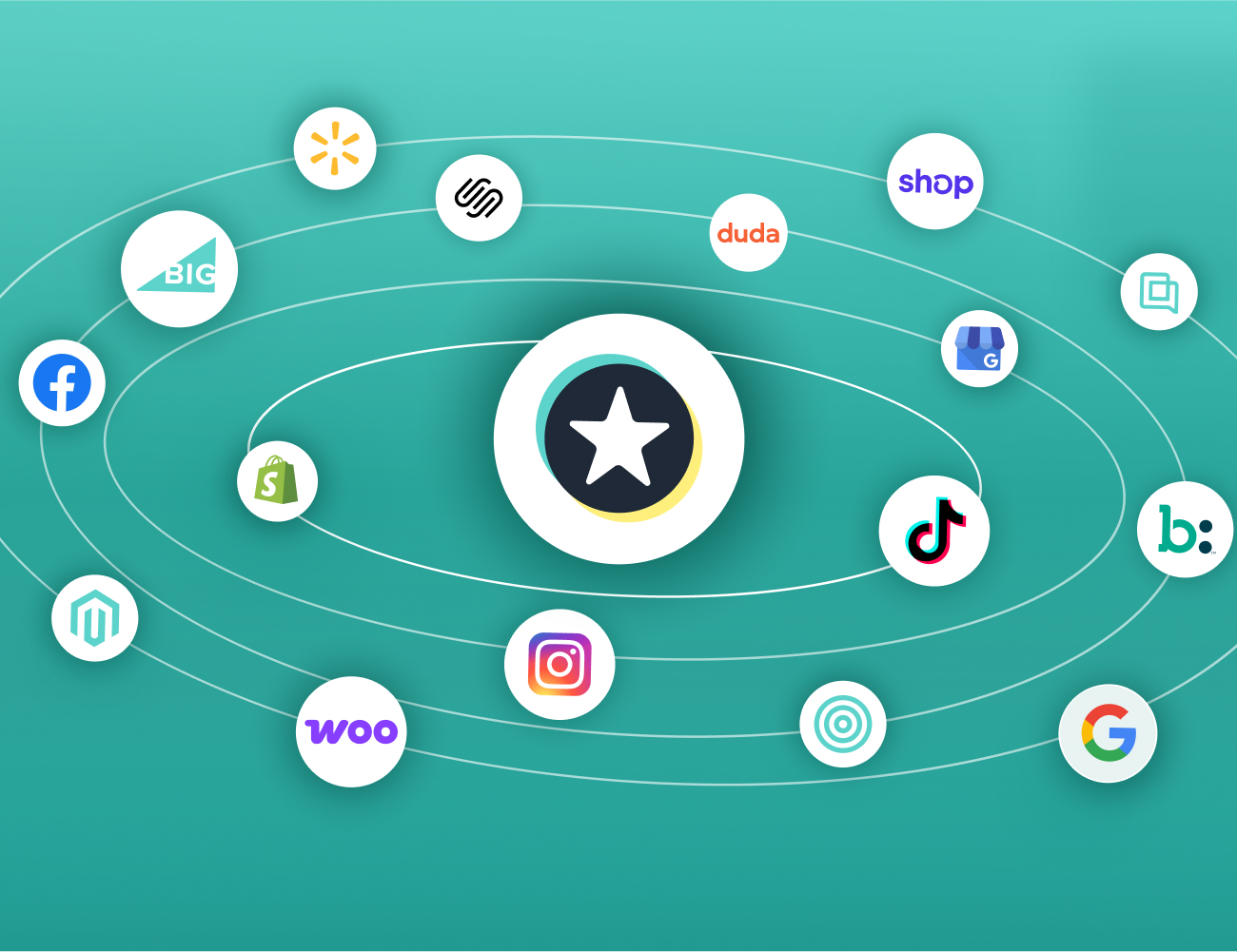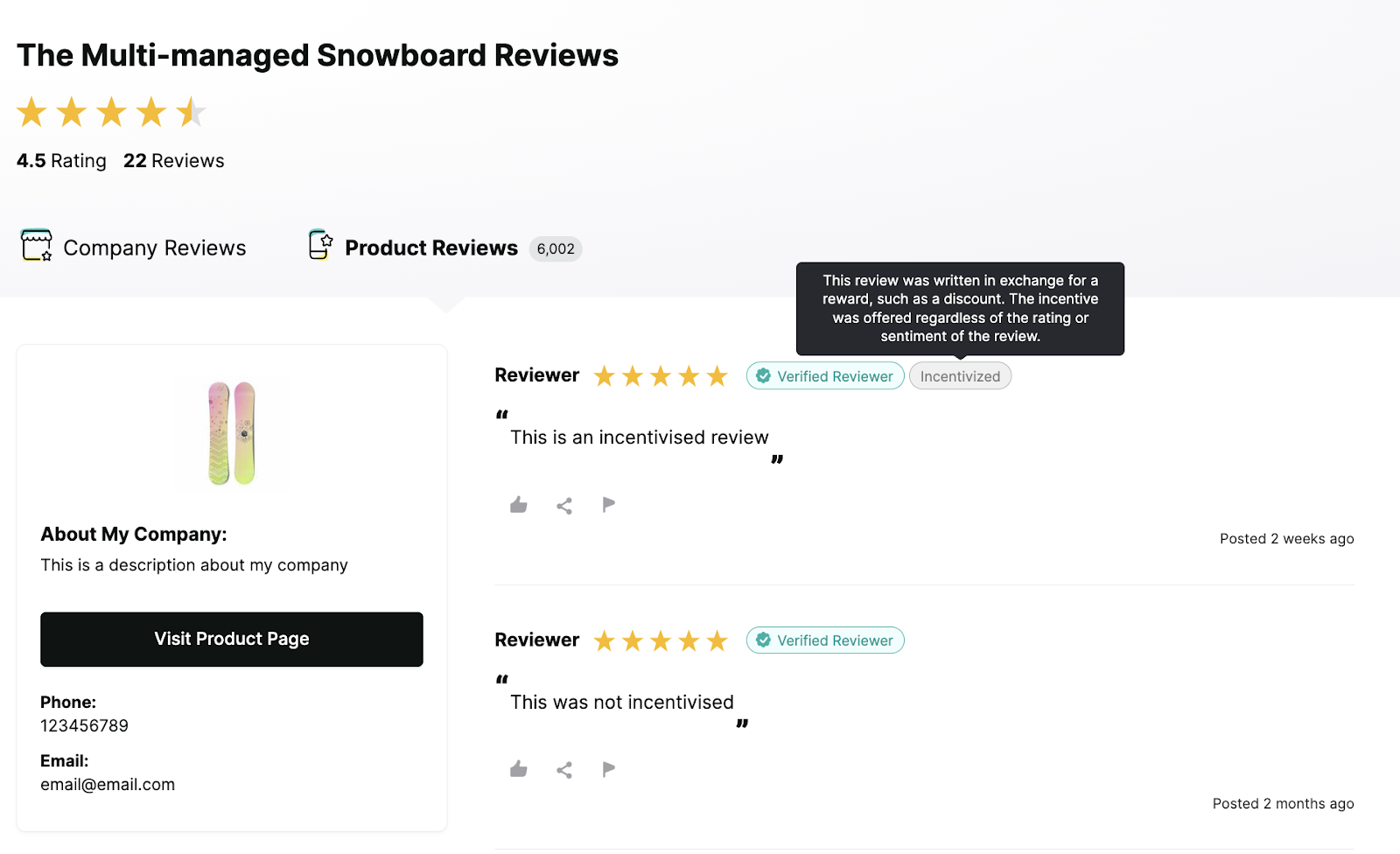
Incentives can be a great way to boost review numbers. But recent changes mean you need to be more mindful about how they’re used.
In the UK, the Digital Markets, Competition and Consumers (DMCC) Act has tightened the rules around fake and misleading reviews - including the use of rewards.
Similar laws exist across the US, Europe and Australia.
So, if you offer discounts, loyalty points, or freebies in exchange for reviews, now’s the time to double-check you’re doing it right.
To make compliance easier, we’ve introduced REVIEWS.io Incentivized Review Tagging - a simple way to clearly label any review collected in exchange for a reward.

It works across multiple collection methods and even integrates with loyalty tools like Influence, so incentivized reviews are flagged automatically.
Want to see how incentivized review tagging works in action?
An incentivized review is a customer review submitted in exchange for a reward - like a discount on a future purchase, loyalty points, or a free gift.
The aim isn’t to buy positive opinions, but to encourage more customers to share their honest experience.
Picture this: you buy a pair of trainers online. A week later, you get an email from the brand:
“Leave us a quick review and we’ll give you 200 loyalty points towards your next purchase.”
That’s an incentivized review. The reward is a thank‑you for your time, not payment for a glowing rating.

Incentives can take many forms, each with specific benefits:
Used well, they can help generate more balanced, authentic feedback from a wider range of customers.
But incentives only work in your favour if they’re done transparently and within the rules. Which brings us to an important point: the legal side.
Yes - incentivized product reviews are legal, as long as you follow the rules. These vary slightly by region, but there are a few universal principles.
The number one requirement is clear disclosure. Customers must be able to see that a review was written in exchange for a reward.
Other key rules to follow:
Regulations covering these principles exist in the UK, US, EU, Australia, and many other markets. And if you sell internationally, you need to comply with the rules in every country you serve.
We’re not legal advisors, so we can’t offer legal advice. However, we have built compliance right into our platform:
These safeguards aren’t add‑ons. They come as standard, so you can stay transparent, trusted, and meet the requirements wherever you sell.
Incentives work best when they’re simple to deliver and meaningful to the customer.
Pots for Tots, a prepared meal delivery service for kids, saw this first-hand using the REVIEWS.io platform with the Influence loyalty integration.
They ran an A/B test on their review invites - one offered 500 loyalty points for leaving a review, the other offered nothing.
The result? A 589% increase in conversion rate for the version with the loyalty offer, showing the kind of uplift that’s possible when rewards are built into your review strategy.
And they’re not just about increasing numbers.
Review incentives can help you collect richer, more useful insights, boost loyalty, and create the kind of user‑generated content that drives sales.
Incentives shouldn’t be your default review strategy. But they can be extremely effective in specific scenarios. Here’s when they make the most sense:
Entering a new region means you’re starting from zero in terms of social proof. Customers don’t yet know your brand or what to expect from your products.
By offering incentives for rewards, you can build credibility faster in new geographic markets.
Even with an established brand, a new product often launches without any reviews. This leaves potential buyers unsure about making that first purchase.
Incentivising early customers to share feedback quickly helps break the “review zero” barrier, builds confidence for others, and gives you insights to refine the product if needed.
Busy periods like Black Friday, Christmas, or back‑to‑school bring a surge of new customers, many of whom may only buy from you once.
Incentivising reviews post‑purchase lets you capture their feedback while the experience is fresh, turn seasonal buyers into repeat customers, and grow a bank of UGC that can be used long after the peak has passed.
If you want more visual content - like photo or video reviews - an incentive is often the nudge customers need. These formats are known to increase dwell time and conversion rates.
They bring your products to life, can be repurposed across social channels or turned into shoppable UGC galleries that inspire.

Some products - like skincare, supplements, or tech - take time for customers to see results or form an opinion.
Incentives sent at the right point in that usage cycle prompt more considered, experience‑based reviews, giving future buyers richer insights and boosting your product’s credibility.
If you’re planning to use incentives to collect more customer reviews, the key is structure.
A well-executed strategy boosts participation, stays compliant, and builds trust with your audience. Here’s how to do it, step by step.
Not all incentives work the same way. The right choice depends on your audience, product type, and what you want to achieve.
The goal here isn’t just to offer “something” but to pick a reward that motivates the right action and fits into your overall customer journey.
Ask yourself:
It’s also important to weigh the value of the reward against the value of the content you’re asking for.
A small incentive might work for a short text review, but a detailed photo or video review may need something more compelling.
Once you’ve chosen your incentive, make sure customers understand exactly what they’re getting, and what they need to do to earn it.
Be upfront about:
Clear terms help build trust and ensure a smooth experience for the customer (and fewer support tickets for your team).
To keep things efficient and consistent, automate as much of your review workflow as possible. That includes:
Tools like Influence (for loyalty rewards) and ViralSweep (for prize draws) integrate directly with REVIEWS.io, so you can handle everything from request to reward in one streamlined flow.
Send your review request at the right moment - after the customer has had time to use the product, but while the experience is still fresh.
As a rule of thumb:
You can also segment based on product type or delivery date to fine-tune your timing.
This isn’t optional. To stay compliant with global regulations, every incentivized review must be clearly marked as such.
This is simple with REVIEWS.io’s Incentivized Review Tagging – a feature that lets you clearly label any review collected in exchange for a reward.

You can tag reviews manually in the timeline, or set automatic tagging within Review Booster, email templates, or dynamic links.
And with our Influence loyalty integration, the process is completely hands-off.
Any review generated as part of a loyalty or rewards program is automatically tagged the moment it’s submitted, with no manual work required.
Whichever method, each tagged review displays an incentive badge and tooltip explaining the reward, so customers understand the context instantly.
This is crucial. Incentives should motivate participation, not skew sentiment. That means:
Make it clear that all opinions are welcome and that honesty matters more than flattery.
Once your strategy is live, keep an eye on how it’s performing:
Test different incentive types, values, and timings to see what works best for your audience. What motivates beauty customers might not work for tech buyers.
Use the data to tweak and refine. Not just your incentive strategy, but your overall review flow.
Offering rewards for reviews isn’t just a tactic to bump up your numbers. It’s a strategy to build trust, strengthen loyalty, and showcase the kind of authentic content that sells your products for you.
When structured well and supported by the right tools, incentivized reviews can give you:
With REVIEWS.io, you get the tools to run incentives safely and at scale - from Incentivized Review Tagging that keeps you compliant in every market, to Influence loyalty integrations and automated workflows that make rewarding customers effortless.
Ready to grow your reviews without risking your reputation?
Start using REVIEWS.io to create a transparent, fully‑compliant incentivized review strategy that builds trust and drives sales. Book your demo today and see how easy it can be.
Yes. Offering incentives for reviews is legal if you follow the rules. You must disclose the reward, apply it to all reviews (not just positive ones), and comply with regulations in every market you sell in.
An incentivized review is customer feedback submitted in exchange for a reward, such as a discount, loyalty points, or a free gift. The purpose is to encourage honest reviews, not to buy positive ratings.
Start by choosing meaningful rewards, disclose all incentives clearly, never ask for only positive reviews, and automate the tagging process. Use tools like REVIEWS.io with built-in compliance features to ensure global legal alignment.
Paying directly for positive reviews is prohibited on most platforms and may lead to penalties. Rewarding honest feedback across all sentiments, with full disclosure, is allowable.


